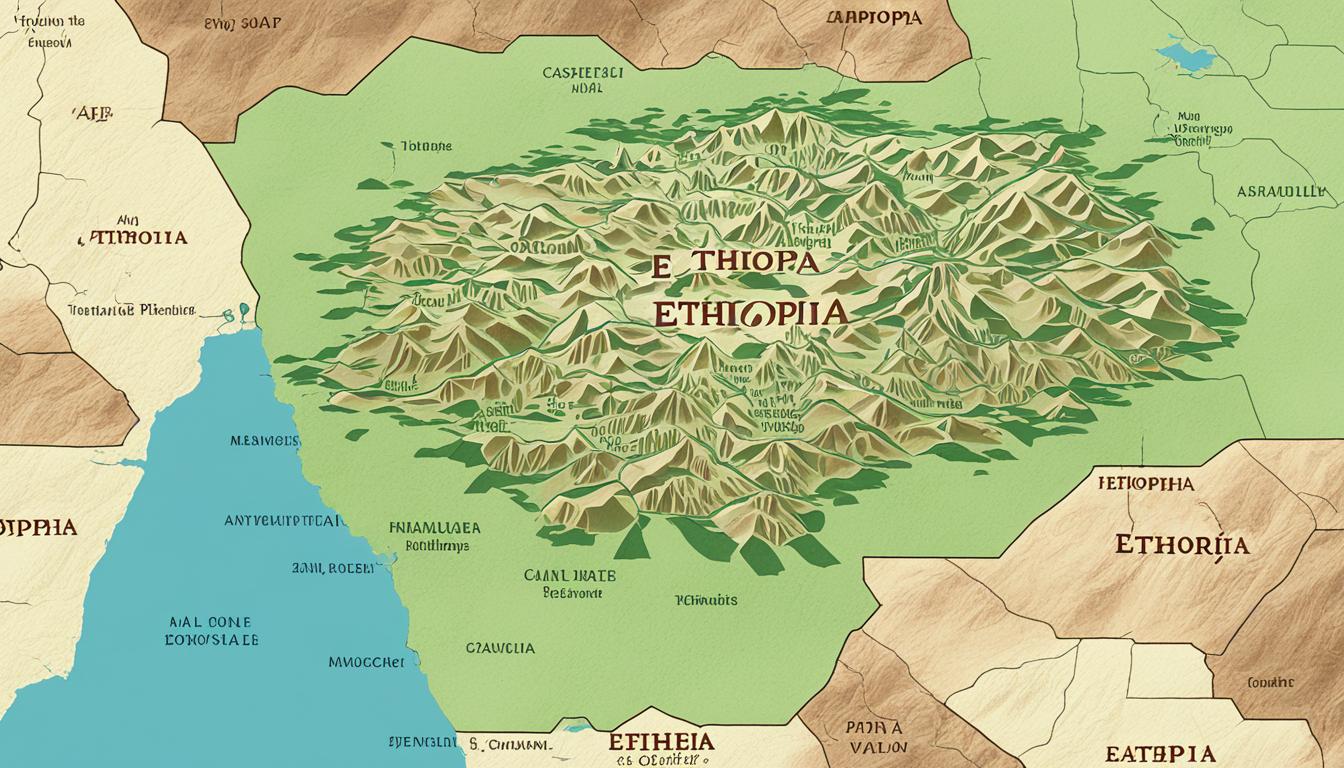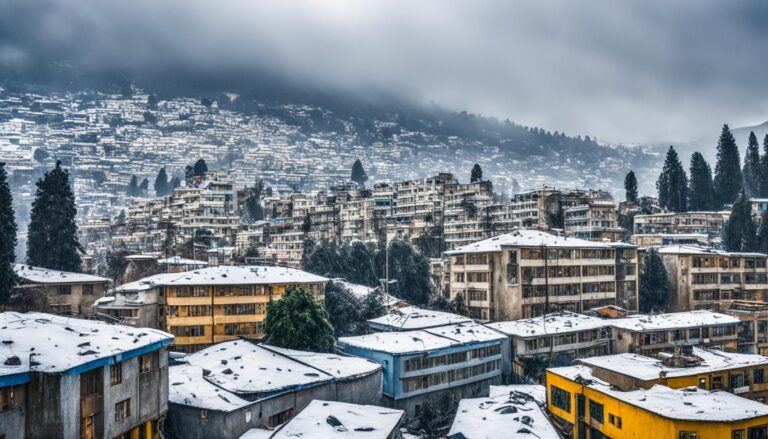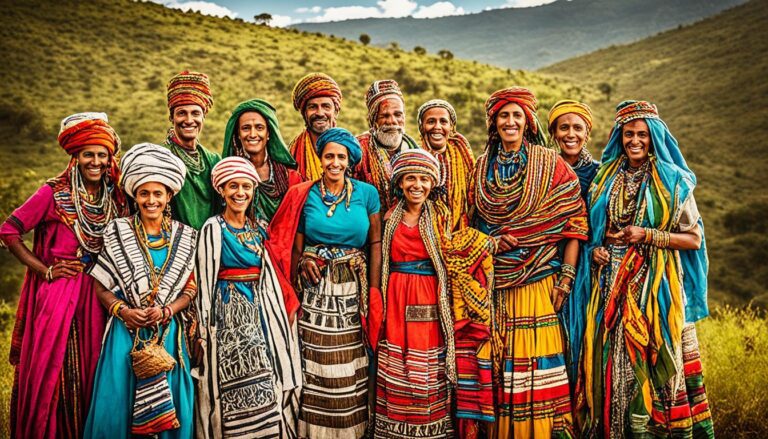How Big Is Ethiopia in Square Miles
Did you know that Ethiopia covers a land area of 1,112,000 square kilometers (429,000 square miles)? To put it into perspective, that’s roughly the size of France and Spain combined. With such vast dimensions, Ethiopia stretches across diverse landscapes, offering a wealth of geographical features and a rich cultural heritage.
From its towering mountain ranges to its ancient historical sites, Ethiopia has much to offer for those seeking adventure, exploration, and an understanding of its unique heritage. Let’s dive deeper into the incredible dimensions of Ethiopia and uncover more fascinating details about this captivating country.
Key Takeaways:
- Ethiopia covers a land area of 1,112,000 square kilometers (429,000 square miles).
- With its vast dimensions, Ethiopia is roughly the size of France and Spain combined.
- The country’s diverse geography and cultural heritage make it a compelling destination for travelers and researchers alike.
- Ethiopia is home to ancient historical sites and remarkable natural landscapes.
- Exploring Ethiopia allows for an immersive experience in its rich cultural traditions and history.
Geography of Ethiopia
Ethiopia, situated in the Horn of Africa, boasts diverse geographical features that span its vast territory. Bordered by Eritrea to the north, Djibouti to the northeast, Somalia to the east and southeast, Kenya to the south, South Sudan to the west, and Sudan to the northwest, Ethiopia covers a total land area of 1,112,000 square kilometers (429,000 square miles).
In the northern region of Ethiopia, the magnificent Abyssinian highlands rise majestically, showcasing the country’s stunning mountainous landscape. These highlands are home to awe-inspiring peaks that ascend over 4,000 meters (13,200 feet). At the pinnacle stands Ras Dashen, reaching a height of 4,543 meters (14,538 feet).
As we venture westward, the grasslands of Sudan unfold, offering a serene expanse stretching towards the horizon. To the east lies the rugged expanse of the Afar desert, displaying the country’s arid beauty. Meanwhile, in the southern reaches of Ethiopia, the Rift Valley Lakes enchant with their picturesque views and diverse ecosystems.
With its captivating geographical features, Ethiopia is a country of remarkable natural wonders, offering a diverse array of landscapes that enthrall travelers from around the world. From the majestic highlands to the desolate deserts and serene lakes, Ethiopia’s geography is truly awe-inspiring.
Population of Ethiopia
As of 2023, Ethiopia has a population of around 128 million inhabitants, making it the 13th-most populous country in the world. With its size and diversity, the country is home to over 80 different ethnic groups, making it a vibrant and culturally rich nation.
The population size of Ethiopia highlights its importance on the global stage. Let’s take a closer look at the key figures and the ethnic makeup of the population:
“Ethiopia’s population of around 128 million people makes it one of the most populous countries in Africa.”
| Ethnic Group | Percentage of Population |
|---|---|
| Oromo | 34.4% |
| Amhara | 27% |
| Sidama | 4% |
| Somali | 4% |
| Tigray | 2.7% |
| Other Ethnic Groups | 28.9% |
As seen in the table above, the Oromo and Amhara ethnic groups constitute a significant majority of the population, accounting for approximately 61.4% of the total. This diversity contributes to the cultural richness that Ethiopia is known for.
With a population of this magnitude, Ethiopia has a diverse and vibrant society that reflects its history, traditions, and cultural heritage. It enables a vast range of languages, traditions, and customs to coexist harmoniously within its borders.
Population Growth and Challenges
The population of Ethiopia has been growing rapidly over the years, placing strain on essential resources such as education, healthcare, and infrastructure. While the government has been implementing measures to address these challenges, there is still progress to be made in terms of improving the overall standard of living for all citizens.
History of Ethiopia
Ethiopia has a fascinating history that stretches back over 3,000 years. It is considered one of the oldest countries in the world and is believed to be the birthplace of humanity. In fact, the Awash Valley in Ethiopia is home to the oldest remains of a human ancestor, dating back over 5 million years.
Ancient Ethiopia flourished around the city of Aksum, which was a significant center of trade and power. It played a crucial role in world affairs, including the legendary Battle of Adwa in 1896, where Ethiopian forces successfully defended their independence against colonial Italy. This historic victory made Ethiopia the only African nation to resist colonization during the colonial era.
“Ethiopia stretches out her hands unto God.”
Ethiopia’s rich cultural heritage is known for its ancient African civilization. The country is home to remarkable archaeological sites, ancient monuments, and historic artifacts that provide a glimpse into its glorious past. The ancient Ethiopian civilization has left a lasting impact on art, architecture, religion, and governance in the region.
This image represents an ancient Ethiopian artifact, showcasing the exquisite craftsmanship and cultural significance of the country’s history:
From the ancient kingdom of Aksum to the architectural wonders of Lalibela, Ethiopia’s history is filled with captivating stories and remarkable achievements. Exploring the historical sites and immersing oneself in the vibrant cultural traditions of Ethiopia is a truly enriching experience.
Geographic Features of Ethiopia
Ethiopia presents a diverse and breathtaking geography that spans from the dramatic Ethiopian highlands to the enchanting rivers that flow through its land. Let’s explore the remarkable geographical features of this captivating country.
The Ethiopian Highlands
The northern and central parts of Ethiopia are dominated by the majestic Ethiopian highlands, also known as the Abyssinian highlands. These rugged mountain ranges boast over 25 peaks that rise above 4,000 meters (13,200 feet), capturing the imagination of adventurers and nature enthusiasts alike. One of the prominent peaks is Ras Dashen, towering at an impressive height of 4,543 meters (14,538 feet). The Ethiopian highlands not only offer breathtaking panoramas but also serve as a habitat for unique flora and fauna.
Ethiopian Plateaus
Across Ethiopia’s vast expanse, numerous plateaus contribute to its diverse topography. The central plateau, with its average elevation between 2,000 and 3,000 meters, adds a layer of undulating beauty to the country’s landscape. These plateaus create a captivating tapestry that stretches as far as the eye can see, captivating visitors with its striking vistas.
Ethiopian Mountains
The Ethiopian mountains form an integral part of the country’s geography, adding to its allure and grandeur. From the Simien Mountains to the Bale Mountains, these ranges offer unparalleled opportunities for hikers, mountaineers, and nature lovers to explore the awe-inspiring beauty of Ethiopia up close.
Ethiopian Rivers
Flowing through Ethiopia’s diverse terrain, rivers play a vital role in shaping the country’s landscape and providing water for its people. One of the most prominent rivers is the Blue Nile or Abbay, which winds its way through Ethiopia for a staggering distance of 1,450 kilometers. These rivers not only contribute to Ethiopia’s natural beauty but also support vibrant ecosystems and provide sustenance for diverse forms of life.
As we immerse ourselves in the geographical wonders of Ethiopia, let us marvel at the Ethiopian highlands, plateaus, mountains, and rivers that define this remarkable country.
Languages of Ethiopia
Ethiopia is a land of cultural diversity, with a rich linguistic heritage. The country boasts over 80 languages and more than 200 dialects spoken throughout its various regions. Language plays an essential role in shaping the identity and cultural fabric of Ethiopian society.
Amharic: As the official language of Ethiopia, Amharic is widely spoken and acts as a lingua franca between different ethnic groups. It is primarily used for administrative, educational, and governmental purposes. Amharic is an Afro-Asiatic language and is written in the Ge’ez script.
Oromigna: Also known as Oromo, Oromigna is the second-most spoken language in Ethiopia. It is primarily spoken by the Oromo people, who constitute the largest ethnic group in the country. Oromigna is an Afro-Asiatic language and has several dialects, reflecting the diversity within the Oromo community.
Tigrigna: Tigrigna is another widely spoken language in Ethiopia, primarily used by the Tigray-Tigrinya ethnic group. It is an Afro-Asiatic language and has its own unique script. Tigrigna is predominantly spoken in the northern part of Ethiopia, including the Tigray region.
“Language is a powerful tool that connects people, preserving their history and traditions. In Ethiopia, the diverse array of languages spoken reflects the richness of our cultural tapestry.”
The Ethiopian government recognizes the importance of preserving local languages and encourages their teaching in schools. This commitment helps foster cultural diversity and ensures the transmission of linguistic heritage to future generations.
In conclusion, the linguistic landscape of Ethiopia is exceptionally diverse, with Amharic, Oromigna, and Tigrigna being among the most widely spoken languages. These languages serve as pillars of cultural identity and contribute to the vibrant tapestry of Ethiopian society.
Religion in Ethiopia
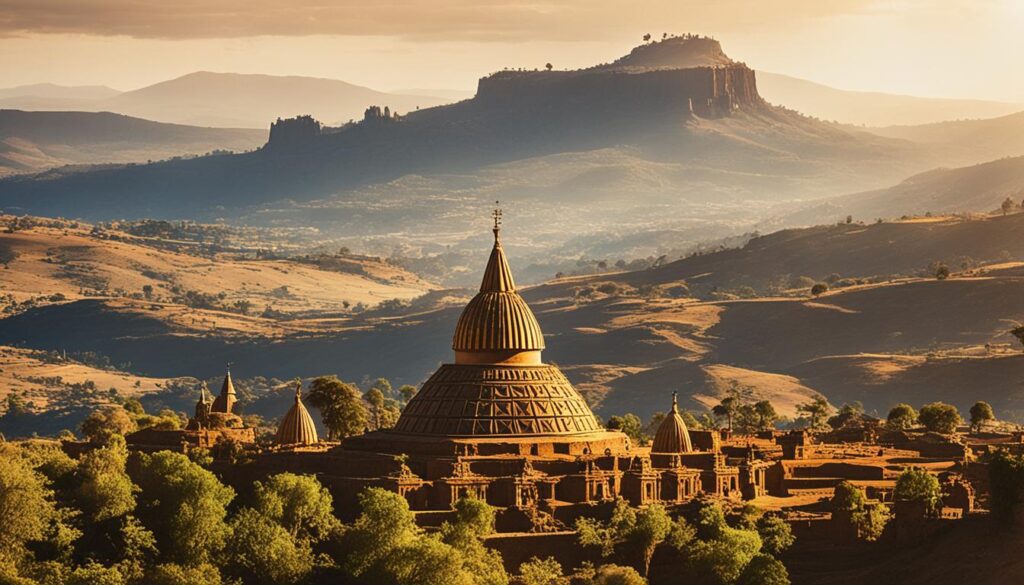
Religion holds a significant place in Ethiopian culture, shaping the beliefs and values of its people. The two dominant religions in Ethiopia are Christianity and Islam, with each playing a vital role in the lives of millions of Ethiopians.
In terms of religious affiliation, Christianity is the most widely professed faith in the country. The Ethiopian Orthodox Tewahedo Church, a branch of Oriental Orthodox Christianity, is the predominant denomination. This ancient Christian tradition dates back to the 4th century AD and has had a profound influence on Ethiopian culture, art, and literature.
Islam also holds a significant presence in Ethiopia. With a sizable Muslim population, especially in the eastern and southeastern regions of the country, Islam has contributed to the diversity of religious practices throughout Ethiopia. Ethiopian Muslims follow Sunni Islam, and mosques serve as centers for prayer, education, and community gatherings.
“Ethiopia has a long history of religious coexistence and tolerance, where Christians and Muslims peacefully cohabitate, fostering mutual understanding and respect.” – Ethiopian Religious Scholar
While Christianity and Islam are the predominant religions, traditional faiths and other religious beliefs also exist in Ethiopia. These ancient belief systems, often characterized by animism and ancestor worship, continue to be practiced in rural areas and among certain ethnic groups.
Religious Diversity in Ethiopia
To provide a comprehensive overview of religious diversity in Ethiopia, here is a breakdown of the religious landscape:
| Religion | Percentage of Population |
|---|---|
| Christianity | 67% |
| Islam | 33% |
| Traditional Faiths and Others | Negligible |
The religious tolerance and coexistence in Ethiopia are reflected in its history, arts, and cultural practices. From the iconic rock-hewn churches of Lalibela to the vibrant celebrations of Orthodox Christian holidays, religious traditions are deeply intertwined with everyday life.
Exploring the religious heritage of Ethiopia allows visitors to gain a deeper understanding of the country’s rich cultural tapestry and the profound influence of faith on Ethiopian society.
Government and Political History
In this section, we will explore the government and political system of Ethiopia, as well as the ruling coalition that has shaped the country’s trajectory.
Ethiopia operates as a federal parliamentary republic, featuring a President, Prime Minister, and a Federal Parliamentary Assembly. This assembly is made up of two houses: the House of Federation and the House of Peoples’ Representatives.
The House of Federation functions as the upper house, representing nine regional states and two chartered cities. It ensures regional interests are upheld and safeguards the constitutional framework of the country.
On the other hand, the House of Peoples’ Representatives serves as the lower house, comprising elected representatives from across the nation. Its primary role is legislative, with a focus on crafting and passing laws that drive the development and progress of Ethiopia.
“The Ethiopian government structures its political system in a way that promotes unity, inclusivity, and cooperative governance.”
The ruling coalition that has been in power since the mid-1990s is the Ethiopian Peoples’ Revolutionary Democratic Front (EPRDF). This coalition is composed of several political parties, each representing a distinct region or ethnic group within Ethiopia.
The EPRDF has played a significant role in shaping Ethiopian politics, driving economic reforms, and promoting social cohesion. Despite criticism and calls for change, the ruling coalition has remained a dominant force in the political landscape of Ethiopia.
| Key Features | Description |
|---|---|
| System of Government | Federal Parliamentary Republic |
| Upper House | House of Federation |
| Lower House | House of Peoples’ Representatives |
| Ruling Coalition | Ethiopian Peoples’ Revolutionary Democratic Front (EPRDF) |
Ethiopia’s government structure and political system aim to foster stability, ensure regional representation, and promote a shared vision for national development.
Next, we will delve into the economic profile of Ethiopia, exploring its key sectors and the challenges it faces.
Economic Profile of Ethiopia
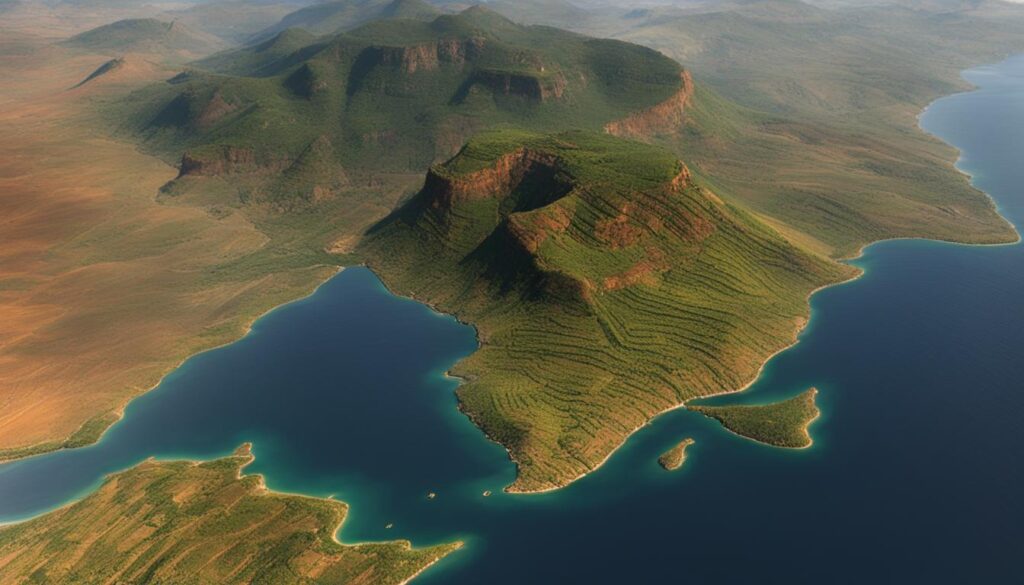
Ethiopia, although considered one of the least developed countries, is also seen as an emerging power in the region. With the fastest economic growth in Sub-Saharan Africa, the country has attracted significant foreign direct investment, particularly in the expansion of the agricultural and manufacturing industries. Agriculture, in particular, plays a crucial role in Ethiopia’s economy, contributing to 36% of the gross domestic product.
However, despite its economic progress, Ethiopia still faces numerous challenges. High poverty rates persist, with a significant portion of the population living below the poverty line. Limited respect for human rights and ethnic discrimination further exacerbate socio-economic inequalities. Addressing these issues remains crucial for sustainable and inclusive development in Ethiopia.
Key Economic Indicators
| Gross Domestic Product (GDP) | Agriculture Sector’s Contribution to GDP | Poverty Rate |
|---|---|---|
| $Insert Ethiopian GDP data | Insert percentage of agriculture sector’s contribution to GDP | Insert poverty rate data |
Economic Growth and Development
Ethiopia’s economic growth has been fueled by substantial investment in the agricultural sector, which contributes to employment opportunities, food security, and overall development. With its favorable climate and vast agricultural potential, Ethiopia has become a key player in the global market for commodities such as coffee, flowers, and sesame seeds.
“Our commitment to agricultural development has not only contributed to economic growth but has also improved the livelihoods of many Ethiopian farmers.” – Addis Ababa Agriculture Minister
The government’s focus on industrialization and infrastructure development has further supported economic growth, attracting foreign investments in manufacturing and construction. This diversification of the economy is crucial for reducing poverty and creating sustainable employment opportunities for the rapidly growing population.
Challenges and Opportunities
Despite the progress made, Ethiopia continues to face challenges in achieving widespread economic development and reducing poverty. Limited access to education and healthcare, particularly in rural areas, hinders human capital development and productivity. Additionally, political instability, bureaucratic hurdles, and corruption pose risks to investment and economic stability.
However, Ethiopia also presents significant opportunities for further growth and development. By investing in sectors such as renewable energy, tourism, and technology, the country can harness its vast resources and young workforce to drive economic prosperity and improve the living conditions of its citizens.
International Relations and Organizations
Ethiopia plays an active role in various international organizations, contributing to global initiatives and fostering positive relations with other nations. Through its active participation, Ethiopia has made significant contributions to the decolonization process in Africa and the growth of Pan-African cooperation.
Ethiopia is a member of several prominent international organizations, including:
- United Nations (UN)
- African Union (AU)
- Organization of African Unity (OAU)
As the capital city of Ethiopia, Addis Ababa is not only a center of cultural heritage and historical significance, but it also hosts the headquarters of the African Union. This makes Addis Ababa a hub for diplomatic activities and a meeting place for leaders and representatives from around the continent.
In addition to its involvement in these organizations, Ethiopia actively engages with numerous global non-governmental organizations that focus on Africa’s development and welfare.
By participating in these international organizations and promoting meaningful interactions with other nations, Ethiopia seeks to foster cooperation, peace, and progress in the global community.
Ethiopia’s Cultural Heritage
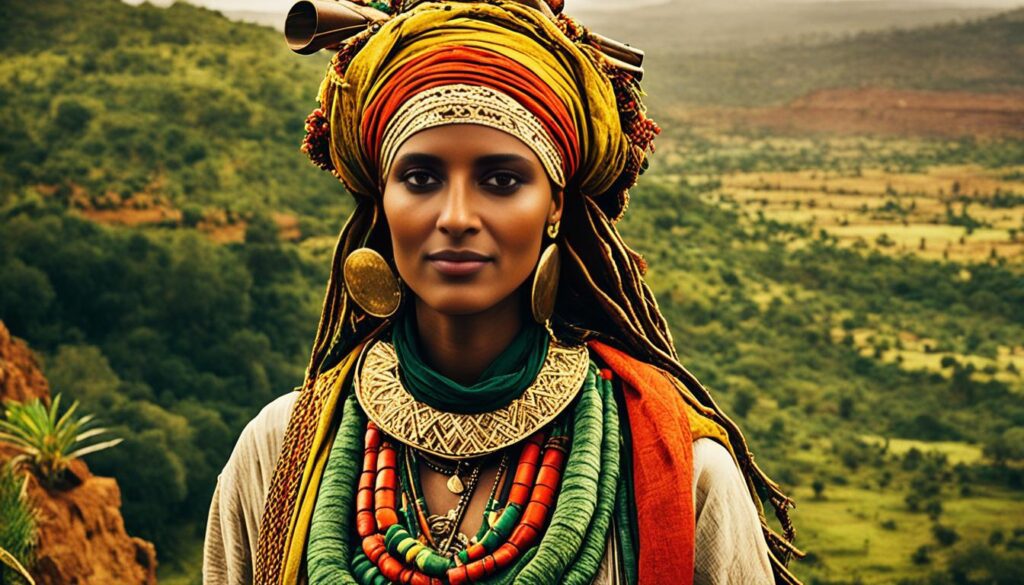
Ethiopia is a country rich in cultural heritage, boasting numerous ancient sites and historical landmarks that are scattered throughout its diverse landscapes. These sites offer a captivating glimpse into the country’s past and contribute to its cultural significance.
One of the most renowned ancient sites in Ethiopia can be found in Axum, located in the Tigray province. Here, visitors can explore the remains of the Queen of Sheba’s palace, a testament to the legendary figure who played a significant role in Ethiopian history. Axum is also believed to be the resting place of the Ark of the Covenant, adding an air of mystique and intrigue to this ancient city.
“Axum, with its ancient ruins and relics, is a treasure trove for history enthusiasts and anyone seeking a deeper understanding of Ethiopia’s past.”
Additionally, Lalibela is another notable UNESCO World Heritage Site that showcases Ethiopia’s architectural wonders. Carved out of solid rock, the 13th-century rock-hewn churches of Lalibela are a remarkable testament to human skill and devotion. These awe-inspiring structures inspire a sense of wonder as visitors marvel at the intricate details and the spiritual significance they hold.
Furthermore, the ancient city of Gondar is known for its magnificent castles and palaces that showcase the artistic and architectural prowess of past Ethiopian rulers. This collection of royal structures, known as the Fasil Ghebbi, is a testament to the country’s rich history and the grandeur of its imperial past.
The cultural heritage of Ethiopia continues to draw tourists from around the world, who are eager to explore the ancient sites and experience the rich traditions and customs of this diverse nation. These historical landmarks offer a glimpse into the country’s past, allowing visitors to immerse themselves in the fascinating stories and legacies that have shaped Ethiopia’s identity.
Ancient Sites in Ethiopia
| Site | Location | Significance |
|---|---|---|
| Axum | Tigray province | Remains of the Queen of Sheba’s palace and possible resting place of the Ark of the Covenant |
| Lalibela | Amhara region | Rock-hewn churches, a UNESCO World Heritage Site |
| Gondar | Amhara region | Fasil Ghebbi – collection of castles and palaces |
These ancient sites are not only treasures of Ethiopia, but also key attractions for tourists interested in exploring the rich history, architecture, and cultural heritage of this remarkable country.
Conclusion
We hope you have enjoyed exploring the wonders of Ethiopia with us. From its vast land area of 1,112,000 square kilometers (429,000 square miles) to its diverse geography and rich cultural heritage, Ethiopia offers a truly unique experience. Whether you are a traveler seeking adventure or a researcher delving into ancient civilizations, Ethiopia has something for everyone.
With over 3,000 years of history, Ethiopia stands as one of the world’s oldest countries. Its ancient African civilization and contributions to world affairs make it a fascinating destination. The country’s stunning geographical features, including the Abyssinian highlands and the Rift Valley Lakes, further add to its allure.
As you explore Ethiopia’s cultural diversity, you will encounter over 80 languages spoken throughout the country, including the widely spoken Amharic, Oromigna, and Tigrigna. Religion also plays a significant role in Ethiopian society, with Christianity and Islam being the two dominant faiths.
In terms of governance, Ethiopia is a federal parliamentary republic with a resilient political system. It actively participates in international organizations, contributing to the decolonization of Africa and promoting Pan-African cooperation.
Furthermore, Ethiopia’s economic profile showcases its growth potential. While the country faces challenges such as poverty rates and human rights concerns, it demonstrates potential as a key player in Africa’s emerging economies.
In conclusion, Ethiopia’s vast land area, rich history, cultural diversity, and promising future make it a captivating destination. Whether you’re interested in exploring ancient sites, experiencing diverse cultures, or witnessing breathtaking landscapes, Ethiopia has much to offer. We invite you to embark on a journey of discovery and unlock the treasures of this remarkable country.

